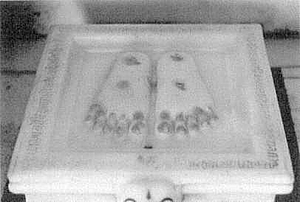The worship of deceased ascetics of note is a central feature of the religious life of Svetambar Jains associated with the Khartar Gacch. Of these the most important by far are the figures known as Dadagurus or Dadagurudevs.[1] The Dadagurus are past Khartar Gacch acaryas who are singled out from others because of their roles as defenders and reformers of Jainism, and as miracle workers and creators of new Jains. The four are: Jindattsuri (1075-1154 C.E.), Jincandrasuri "Manidhari" (1140-1166), Jinkusalsuri (1280-1332), and Jincandrasuri II (1541-1613). These figures are the focus of a widespread cult.[2]
Most temples affiliated with the Khartar Gacch contain images of the Dadagurus. There are also many shrines - called dadabaris, "gardens of the Dada" - dedicated specifically to them. The temple complex at Mohan Bari is, in fact, a large dadabari Even in dadabaris, however, images of the Tirthankars are present - as we see in the case of Mohan Bari - and, in theory, are the primary objects of worship. Dadabaris are basically mortuary structures. Although many of them have been enveloped by urban growth, the ideal is for dadabaris to be away from population centers, as would be appropriate for a place where funerary rites take place. The complex at Mohan Bari functions in this way today.
There are several dadabaris in Jaipur, the most important being a temple located on Motidungri Road to the south of the old city. This temple is owned by the Srimals and is a major Jain landmark in Jaipur. The most famous dadabaris of all, however, are located at Ajmer, Mehrauli (near Delhi), and Malpura (some 80 kilometers southeast of Jaipur). Those at Ajmer and Mehrauli are located on the spots where, respectively, Jindattsuri's and Jincandrasuri Manidhari's obsequies took place. The dadabari at Malpura was supposedly founded as a result of a vision that Jinkusalsuri gave just fifteen days after his death (to be discussed later). A directory of dadabaris published in 1962 lists 344 independent shrines and 210 larger temples in which the Dadagurus are represented, mainly in Rajasthan and Madhya Pradesh (Josi 1962). Many more exist now.
The Dadagurus are usually worshiped in the form of foot images, but anthropomorphic images have become more common in recent times (Figures 10, 11).[3] It is clear, however, that footprints are more fundamentally in character for the Dadagurus than anthropomorphic images, because even when there is an anthropomorphic image there are usually footprints too.[4] The structures in which the Dadagurus' images are housed are modeled on the funerary cenotaphs that are so common a feature of Rajasthan. Even where temple-like buildings have been erected for the Dadagurus, their images - whether footprints or anthropomorphic figures - are usually housed in cenotaph-like shrines within.

Figure 10.
Footprint image of a Dadaguru at Sanganer, near Jaipur
We may say that deceased ascetics constitute a general class of objects of worship. The Dadagurus are different in degree from other deceased monks, not different in kind. They are the most beloved, respected, and powerful of them all, but - as we have seen in the case of Chagansagar - other ascetics have achieved postmortem recognition. As I have already suggested, the Tirthankars can also be seen as members of this class, but this statement requires qualification. The distinction between the Tirthankars and ordinary deceased ascetics is never in doubt; the Tirthankars have achieved omniscience and liberation, whereas even ascetics as distinguished as the Dadagurus have not. The namaskarmantra establishes a clear hierarchy among ascetics, with the Tirthankars unambiguously at the top. But at the same time, Tirthankars are deceased ascetics too. As noted before, Rsabh is represented at Mohan Bari by feet, not by an anthropomorphic image.[5] Moreover, these footprints are stationed under a chatri -like structure. This is an unusual arrangement, but the fact that it is a plausible arrangement suggests that in some respects the Tirthankars are thought of as belonging to the same category as other deceased ascetics. The physical homologies seen in the arrangements at Mohan Bari suggest a common conceptual substratum. Rsabh is a deceased ascetic too, who has left footprints behind.

Figure 11.
Image of Jincandrasuri "Manidhari"
at a neighborhood temple in Jaipur
The Dadagurus are absolutely central to the beliefs and practices of Svetambar Jains associated with the Khartar Gacch. They are objects of worship, and in some ways are ritually more prominent than the Tirthankars themselves. To understand their role we must learn something about their place in history, and this in turn requires that we learn something of the history of the Khartar Gacch.
On the Dadagurus, see also Laidlaw 1985. The term dada means "paternal grandfather"; guru means "spiritual preceptor."
An early precedent for the Dadagurus' cult may have been the cult of Gautama (Mahavir's foremost disciple and usually called Gautam Svami by Svetambar Jains), which had emerged among Svetambars by medieval times and was, as is the Dadagurus' cult today, associated with worldly prosperity (Dundas 1992: 33-34). Unlike the Dadagurus, however, Gautama has achieved liberation. For an excellent description and analysis of Gautama's role in contemporary Svetambar ritual, see Laidlaw 1995: Ch. 17.
The latter can be easily distinguished from images of the Tirthankars by the usual presence of three symbols: the muhpatti, ogha, and book. The muhpatti is the cloth that ascetics hold before their mouths when speaking to avoid harming small living things in the air; the ogha is the moplike implement that ascetics use to brush surfaces free of small life-forms before sitting or lying. The book symbolizes the teaching function of ascetics.
There is nothing uniquely Jain in the emphasis on feet. From early times the Buddha was represented by footprints. Ritual attention to the feet of important persons, deities, and ascetics is a pan-Indian theme. See Babb 1986, esp. Ch. 3, for Hindu examples.
 Prof. Dr. Lawrence A. Babb
Prof. Dr. Lawrence A. Babb
